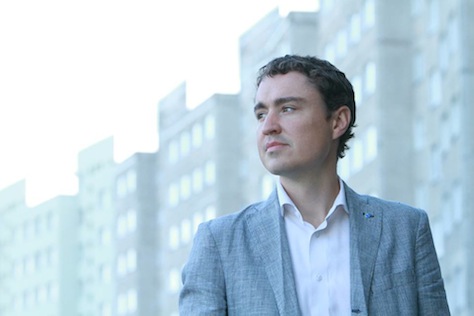Last week, when Estonia’s nine-year prime minister Andrus Ansip stepped down, virtually everyone thought that Estonia’s European commissioner Siim Kallas (himself, briefly, a former prime minister) would step into Ansip’s shoes as the Eesti Reformierakond (Estonian Reform Party) prepares to put itself on a stronger footing for expected March 2015 elections.![]()
After all, Kallas helped found the Reform Party in the mid-1990s, served as a highly regarded president of Estonia’s central bank in the early 1990s, and held several posts in government before leaving for Brussels in 2004, where he’s amassed plenty of additional experience — as a vice president of the European Commission since 2010.
Instead, Kallas faced renewed controversy over $100 million in loan guarantees that he signed while central bank governor in 1994. Moreover, the concept that Kallas could wage a shadow campaign for prime minister while still officially a member of the European Commission ruffled feathers in both Tallinn and Brussels — even more so in light of open rumors that Kallas and Ansip would simply trade jobs, with Ansip stepping into Kallas’s shoes at the Commission.
Kallas formally ruled out a return as prime minister on Wednesday, and the Reform party nominated instead Taavi Rõivas (pictured above), social affairs minister since just December 2012. At age 34, he would be the youngest head of government in Europe, and notably, the first Estonian leader who was just a child when the Soviet Union collapsed — Estonia won its independence just five days short of Rõivas’s 12th birthday.
From March 4, the date of Ansip’s resignation, Estonian president Toomas Hendrik Ilves had two weeks to name a new government. The working assumption is that Ilves, despite his social democratic background, would name Kallas to lead a government with the support of the center-right Reform Party and its most recent coalition partner, the conservative Isamaa ja Res Publica Liit (IRL, Pro Patria and Res Publica Union).
But Reform’s decision to name Roivas as its prime ministerial candidate may open new possibilities — in the course of Ansip’s three cabinets over the past nine years, Reform partnered not only with IRL, but with the two other major parties in Estonian politics, the Eesti Keskerakond (Estonian Centre Party), an alternative liberal party that leans slightly more to the center-left and which draws the support of Estonia’s sizable ethnic Russian population, and the more traditionally leftist Sotsiaaldemokraatlik Erakond (Social Democratic Party). Both the Centre Party and the Social Democratic Party draws more support in polls today than Reform.
No party today holds a majority in the 101-member Estonian parliament, the Riigikogu, though Reform, because it holds the most seats (34), will almost certainly have the first chance to form a government by partnering again with IRL (22 seats) or with the Centre Party (21 seats) or the Social Democrats (21 seats).
So who is Rõivas? And what can we expect if he becomes prime minister for the next 12 months in Estonia?
Rõivas comes to the role not only after the Kallas debacle, but also after Urmas Paet, foreign minister since 2005, ruled himself out of consideration and after defeating justice minister Hanno Pevkur by just one vote within the Reform Party’s parliamentary caucus.
Before winning a seat in the Estonian parliament in 2007, Rõivas had always been an Ansip protégé, serving jointly as an advisor to Ansip and on the Talllinn city council between 2005 and 2007. Prior to becoming social affairs minister, Rõivas chaired the parliament’s finance committee and the European affairs committee.
Rõivas is perhaps more well-known as the partner of Estonian pop star Luisa Värk, with whom the prime ministerial hopeful shares a daughter.
His youth — and relative inexperience — caught Estonia off guard, though it’s too early to tell if the surprise choice can pull together a new government or if Rõivas can breathe new life into the Reform Party in the next 12 months:
“I think that it is reasonable to give people time to get used to the idea,” he said, commenting upon a quick poll by the Postimees newspaper portal, according to which 88 percent of people think that he is not the right person for the job of prime minister. “My task now is to reach a state where we have a working government. Let’s work on that first.”
He wouldn’t be the youngest prime minster in Estonia’s short post-independence history, however — Mart Laar was just 32 years old when he became prime minister (for the first time) in 1992. His premiership ended with scandals and a no-confidence vote, though in two years Laar introduced a rash of economic reforms designed to liberalize Estonia’s economy, privatize Soviet-era national industries, reduce subsidies and institute Estonia’s flat tax. Laar, a member of IRL, ultimately returned to power for a second term as prime minister from 1999 to 2002.
Rõivas won’t have as much time as Laar had in 1992, however, given the unhappiness of the Estonian electorate with the country’s slowing economic growth (especially in comparison to much stronger GDP growth in Lithuania and Latvia). If Rõivas leads the Reform Party to a devastating defeat next year, he may find himself following in the footsteps of another young conservative leader, William Hague, who won the Conservative Party’s leadership in the United Kingdom at age 36, only to resign the leadership four years and a landslide electoral defeat later.
